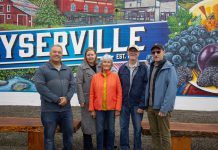Following a discussion on state housing laws in a joint city council and planning commission session July 14, Cloverdale city officials heard a presentation on potential methods of increasing mixed-use residential development in the downtown area.
The city could do this by changing the zoning designations in the area to incorporate more mixed-use and high-density residential.
Bruce Bruebaker, principal of Placeworks, an urban planning consultancy firm, gave the presentation on how the city might update zoning districts in the downtown area in order to increase infill development.
Bruebaker highlighted two sites along Cloverdale Boulevard as “opportunity sites” for development in the area, and used them to illustrate existing barriers in the municipal code that must be addressed to increase development.
The goals of the rezoning project are to attract new downtown development in alignment with the city priorities amid state pressure on local jurisdictions to increase the housing stock. Other goals include providing new or different housing types, such as flats and townhouses, at lower costs, increasing the population in the walkable city center to reduce driving and promote local businesses and supporting the use of existing and future public transit options.
Placeworks identified several areas for potential infill development in downtown Cloverdale, including the south and southwest portions of downtown and pockets east of Highway 101.
Of the two opportunity sites highlighted by Placeworks, one is just under a quarter-acre, and the other is just over a half-acre, which Bruebaker said underscores the nature of small, infill development potential in the downtown.
“We’re not really talking about giant development. It’s just not possible to achieve major or obtrusive developments on these lots,” Bruebaker said.
The smaller of the two hypothetical projects would be located in a vacant lot on the west side of Cloverdale Boulevard across from the plaza, with the majority of the lot acreage designated for parking. Along the road, there could be a three-story mixed-use project with retail on the ground floor and seven residential units above. The third story would be set back from the street, achieving a terraced aesthetic.
The larger of the two would be situated along Cloverdale Boulevard between the plaza and East First Street, and would require the demolition of existing structures. It would feature 5,500 square feet of retail with eight apartments or flats on the second story, with four townhouses along another border. Parking would take up the remaining space, with some townhouse parking available underneath the respective units.
The main suggestions for amending municipal code Bruebaker raised included increasing density allowances and reducing certain parking standards. The Cloverdale West project, for instance, would require 31 units per acre allowed density, however, the downtown area is zoned for only 20. While the Cloverdale East project would be closer to the goal, with 21 units per acre, it would also require a density modification.
Developers would have difficulty making projects cost effective without increased density.
Bruebaker also said parking use permits which would be required to make projects feasible, could cause would-be developers uncertainty. He also recommended taking advantage of vacant sites — which would be more feasible because they wouldn’t require demolition or relocation costs — but said that higher density would be required.
City Manager David Kelley told city officials that increasing mixed-use and residential development in the downtown core would not only be in line with Cloverdale’s downtown historically, but would also help promote a vibrant, economic hub in the area.
“One of the reasons council may want to support increasing housing units in the downtown is that it has the effect of increasing your daytime population,” Kelley said. “The daytime population is critical to the ability of businesses to support themselves. It’s folks who maybe work from home and are able to walk immediately out their door and buy the retail goods and services they’re seeking without driving a vehicle.”
Infill development will also likely be a necessary method of meeting the city’s Regional Housing Needs Allocation (RHNA) numbers, doled out by the state and regional agencies and tied to funding. The City of Cloverdale will have to facilitate the construction of at least 278 new housing units over the next eight-year cycle, beginning in 2023.
According to the staff report, Cloverdale was awarded $160,000 in state funding as part of the SB2 Planning Grants Program to offset costs of consulting and planning associated with increasing development.









